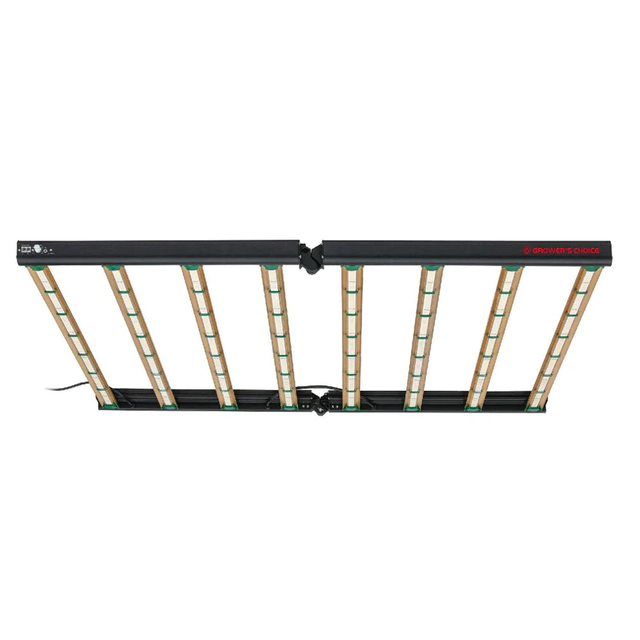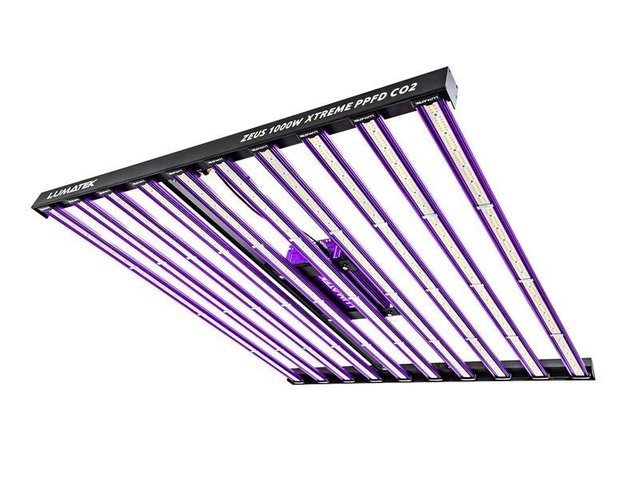Lumatek Zeus 1000W Xtreme PPFD LED Grow Light VS Grower's Choice ROI-E900 LED Grow Light
While many houseplants do just fine indoors with whatever natural light flows through your windows, certain ones can be coaxed to bloom more reliably or will grow more healthy leaves, with additional light from artificial sources. And if you’re starting vegetable and annual flower seeds indoors, they often need the help of lights to develop properly. While the amazing power of sunlight is tough to completely replicate, using grow light fixtures fitted with simple fluorescent or LED bulbs can come close. Here’s what you need to know about setting up the best light systems for your houseplants and seedlings.
Where should grow lights be located?
In general, grow lights for mature plants should be 1–3 feet away, although seedlings and sprouts can tolerate low-intensity lighting within a few inches in their initial periods of rapid growth.
If your plant is in a reflective grow space, like in an indoor grow tent, then higher is better for the light to be better reflected by the walls to reach the lower stems and leaves. A narrowly focused light may need to be set further away than a wide spread light to make sure to not burn the leaves. An LED or CFL light can be closer than an incandescent light. Always consult the directions provided by the manufacturer should give you the specifics for the intensity and model of light you’ve chosen, keep an eye on the plant(s), and adjust as necessary.
Signs a grow light is too close to a plant
If your grow lights are too close to your plants, they will show some telltale signs of overexposure, much the same as they would if placed in direct sunlight for too long. These include:
Browning edges or burnt spots
Curling or wrinkling
Drying out
Pale or whitish coloration
Signs a grow light is too far from a plant
When plants aren’t getting enough light, either from too little sunlight or grow lamps that are too far away or too weak, they’ll show the following signs:
Long, leggy stems
Small and sparse leaf growth
Pale or whitish coloration
Lumatek Zeus 1000W Xtreme PPFD LED Grow Light
Features:
Lumatek LED grow light is designed for 1.5 x 1.5m coverage with Supplemental CO2 for optimal efficiency and results. The higher specification Lumatek Zeus 1000W Xtreme PPFD CO2 LED is a linear multi-light bar fixture producing extremely high levels of PPF of 2925 µmol/s and a Photon Efficacy (fixture efficiency) of 2.9 µmol/J. Lumatek full spectrum horticultural LED solutions balance light quality (spectra) with light quantity (intensity and duration) ensuring an even light distribution and uniform spread. The use of CO2 with this fixture is not mandatory, but to run it without it, then we recommend a longer canopy distance to the light, ensuring the optimal PPFD levels accordingly to the grow stage. Supplementation use of Carbon Dioxide (CO2) in your controlled environment can significantly improve the yield of your crop if used correctly. The new line of Zeus is built using high-quality Lumatek drivers and the latest generation top bin LEDs from Lumileds and Osram, generating a full-spectrum light source ideal for veg and flowering cycles.
Grower’s Choice ROI-E900 LED Grow Light

Features:
This Grower’s Choice LED grow light boosts up to 1,000 watts of supercharged photon output. Using Growers Choice’s proven PAR formula, the ROI-E900 utilizes our unique PAR formula and 3k full-phase spectral radiance into a 4'x5' growing space, producing tremendous light output and canopy coverage. Designed to accommodate commercial growers with wider tables or trays, the ROI-E900 offers the greatest potential for extended coverage, penetration and premium yields. The ROI-E900 will give you more power and more flowers!
What to Consider When Purchasing an LED Grow Light
Light Spectrum
Just as you’ve heard that the sun has an electromagnetic spectrum, the same principle applies to LED lights. There are several different color frequencies that you should know: blue light, purple light, red light, and white light. Certain lights are more optimal for certain plant growth stages.
For example, blue light helps with chlorophyll synthesis, while red light is great for blooming. You should be looking for the types of light that each grow light offers. Even when the product is deemed ‘full-spectrum,’ you can look into exactly how many lights of each frequency it has.
Light Intensity
There are two different approaches when it comes to light intensity. The first is photosynthetic photon flux (PPF) or photosynthetic photon flux density (PPFD). This is important because it tells us how much light plants absorb from the LED grow lamp. When researching your grow light, cross reference how much light your plant needs with how intense the PPF or PPFD is. The other perspective is from lumens, which measure how much visible light the grow light omits.
How Long Do LED Grow Lights Last?
The lifespan of LED grow lights depends on the type of lamp. Smaller, standard LED grow lights will last about 30,000 to 50,000 hours. More powerful LED grow lamps have an average 100,000-hour lifespan. And, many brands offer warranties so that when it comes time to replace your light, it will be covered. Most of these types of lamps may need a part replaced in about a year or so.
Conclusion
Quality LED grow lights are our current best solution for growing plants indoors. They are more efficient than traditional forms of light, which means they produce more output while using less electricity and producing less heat. They also last longer. You don’t have to replace bulbs for at least 5 years, usually more than 10 years.

You should be looking for the types of light that each grow light offers.